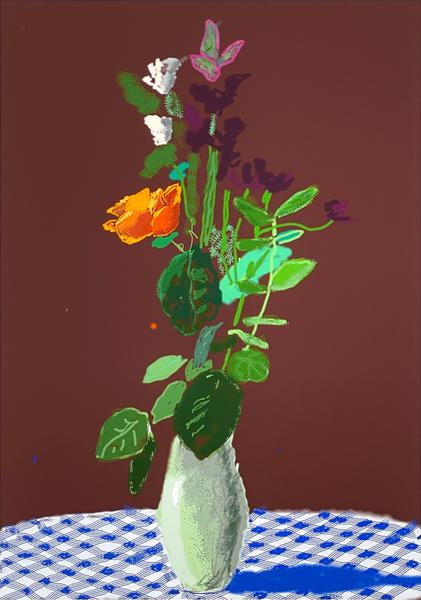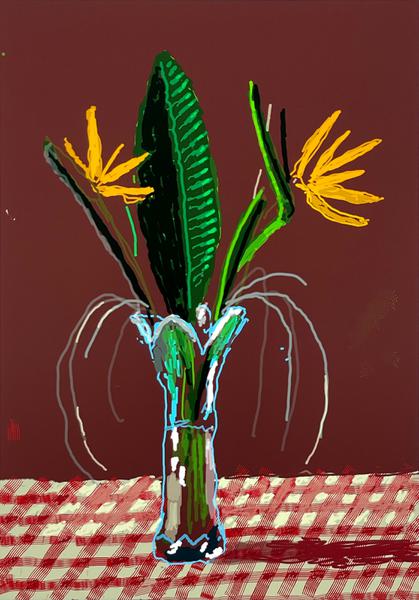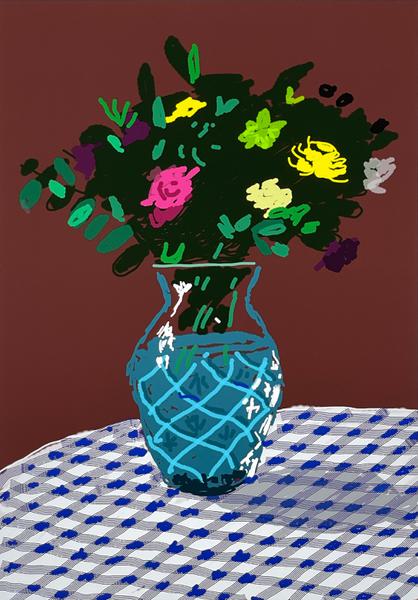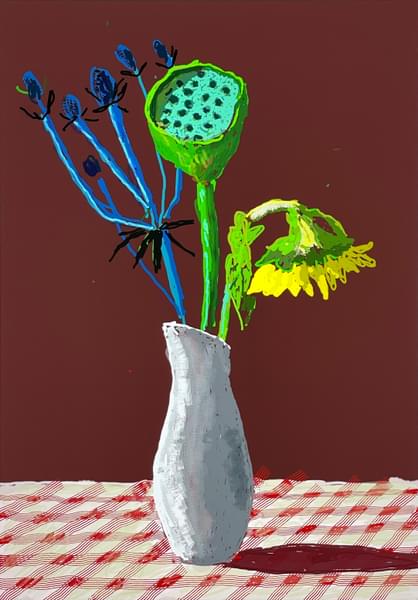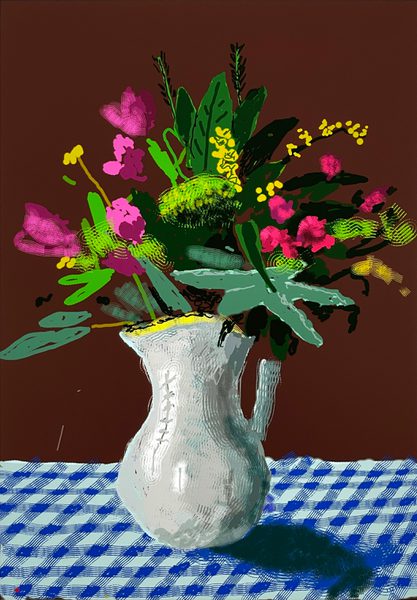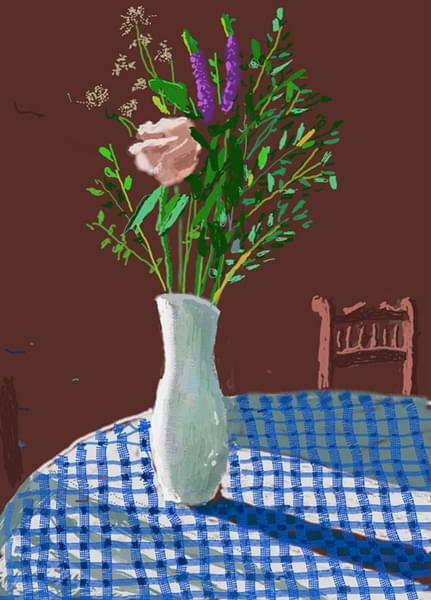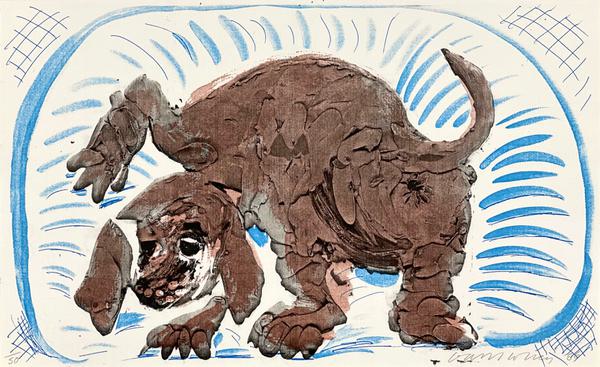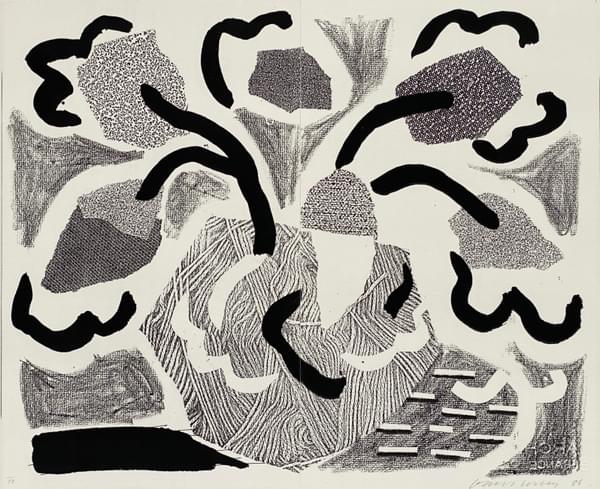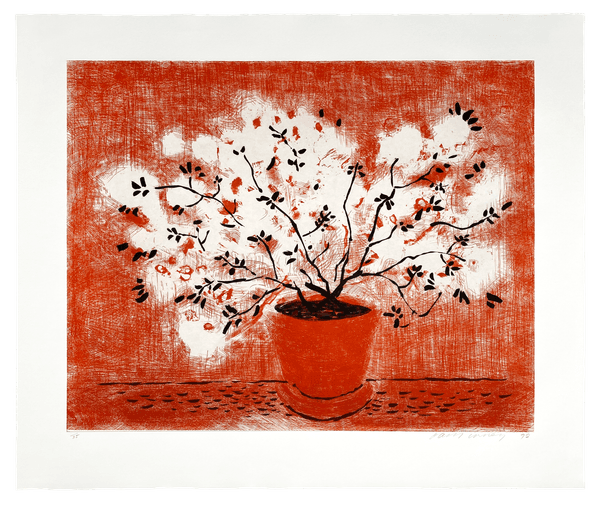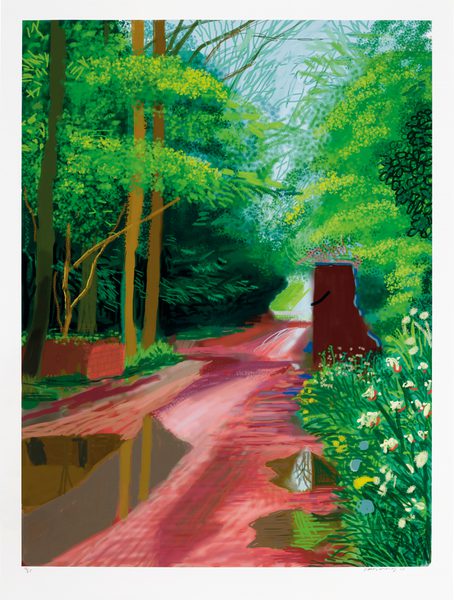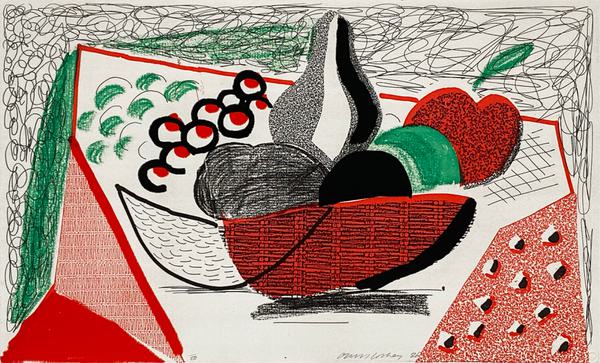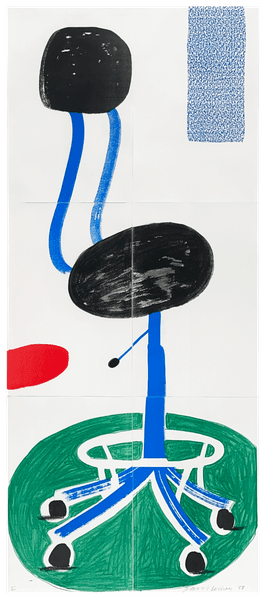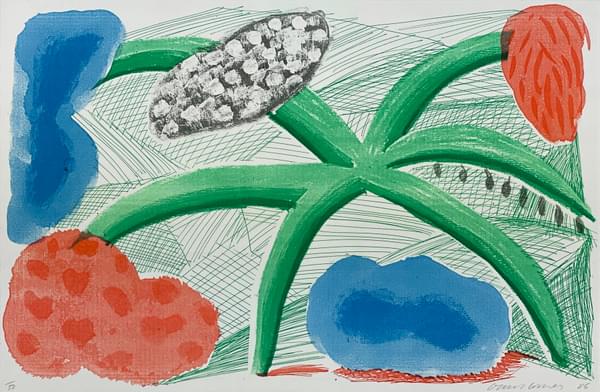Almost Like Skiing
With whimsical abstracted forms standing proud upon a stage, Almost Like Skiing dates from an experimental phase in David Hockney's distinguished career. Set amongst vividly coloured, interlocking shapes, Hockney has conjured before us a theatre stage that is almost cubist in its composition. A painterly frame of deep royal blue and shadowy greys evokes the darkness of the auditorium, drawing our eye to the brightly lit stage and its lyrically surreal backdrop. Painted in 1991, it is directly contemporaneous with the set designs Hockney was producing for Richard Strauss's Die Frau Ohne Schatten, performed at the Royal Opera House at Covent Garden in London the following year.
Almost Like Skiing has a celebratory energy that seems to revel in the freedom that Hockney found returning to paint and canvas after designing sets. Perhaps referencing the way in which he has manipulated the journey of the eye through form, texture and colour, the title is evoked in the sweeping curves, leading pathways and tumbling forms. Our gaze soars round the composition in sweeping curves, guided first by the fresh green that swoops through centre of the work, led along a slim white path up to the top right, doubling back across the width of the composition, and finally plunging down a sequence of curving triangles onto the stage below.
A visual precursor to his series of Very New Paintings, painted and exhibited in 1992, Almost Like Skiing shows Hockney reconnecting with the modernist principles enunciated by abstract artists and theorists, and exploring the limits of realism and abstraction that he so admired in Picasso. Combining a belief in the expressive potential of non-figurative painting with his masterful understanding of perspective and illusionistic space, Hockney's abstract works from this period are above all extraordinarily inventive responses to subjective experiences. 'Although I am interested in theory, I am not of course a theoretician. Picasso or Braque would have looked at their pictures after they were painted, they were not self-consciously thinking of Cubist theory while they painted. You allow a semi-consciousness to tell you how to go on, or else the painting would be intentional, and you couldn't be doing it intentionally. You make the discoveries of what is going on inside you; you don't need to know this; you work intuitively. Cubism was discovered intuitively, it was all intuition. Most artists, good artists, trust their intuition. I trust mine' (D. Hockney, quoted in That's the way I see it, London, 1993, p. 131).
These works and the Very New Paintings that immediately followed, have their origins in Hockney's paintings of the Grand Canyon. As the artist has stated, the Grand Canyon is "the biggest space you can look out over that has an edge".
Almost Like Skiing
- Artist
- David Hockney (b.1937)
- Title
- Almost Like Skiing
- Medium
- Oil on canvas
- Date
- 1991
- Size
- 36 x 48 in : 91.4 x 121.9 cm
- Provenance
- Private Collection, USA
Anon. sale, Christie's New York, 11 November 2004, lot 192
Peter Findlay Gallery, New York
Collection of Carolyn and Bill Powers (acquired from the above in 2005)
Anon. sale, Christie's London, 26 June 2013, lot 127
Private Collection - Exhibited
- Chicago, Richard Gray Gallery, David Hockney: Recent Pictures, 1992, illustrated in the catalogue colour p. 15
Venice, L.A. Louver Inc., David Hockney; Some New Paintings, Drawings, Prints and Gouaches 1989 - 1994, 1994 - Literature
- The David Hockney Foundation, thedavidhockneyfoundation.org/chronology/1991
https://www.thedavidhockneyfoundation.org/artwork/1897
Documentary: David Hockney: The Colors of Music, 2003 - 0.31 - 0.35, 45.10 - 45.16, 52.15, 52.22- 52.30 - https://vimeo.com/12991557 - Reference
- AC24-07
- Download PDF
- Status
- Available
Available Artists
- Ancart Harold
- Andre Carl
- Avery Milton
- Baldessari John
- Barnes Ernie
- Brice Lisa
- Brown Cecily
- Calder Alexander
- Castellani Enrico
- Condo George
- Crawford Brett
- Da Silva Maria Helena Vieira
- Dadamaino
- Dali Salvador
- Dávila Jose
- de Tollenaere Saskia
- Downing Thomas
- Dyson Julian
- Elsner Slawomir
- Fontana Lucio
- Freud Lucian
- Gadsby Eric
- Gander Ryan
- Gnoli Domenico
- Guston Philip
- Haring Keith
- Hartung Hans
- Held Al
- Hockney David
- Jones Allen
- Katz Alex
- Kentridge William
- Kitaj R. B.
- Knifer Julije
- Kusama Yayoi
- Le Parc Julio
- Leciejewski Edgar
- Levine Chris
- LeWitt Sol
- Magritte René
- Marchéllo
- Mathieu Georges
- Mavignier Almir da Silva
- Miller Harland
- Mitchell Joan
- Modé João
- Morellet François
- Nadelman Elie
- Nara Yoshitomo
- Nesbitt Lowell Blair
- O'Donoghue Hughie
- Odita Odili Donald
- Perry Grayson
- Picasso Pablo
- Pickstone Sarah
- Prehistoric Objects
- Quinn Marc
- Richter Gerhard
- Riley Bridget
- Ruscha Ed
- Scott William
- Serra Richard
- Shrigley David
- Smith Anj
- Smith Richard
- Smith David
- Soto Jesús Rafael
- Soulages Pierre
- Spencer Stanley
- Taller Popular de Serigrafía
- The Connor Brothers
- Turk Gavin
- Vasarely Victor
- Warhol Andy
- Wood Jonas
- Yiadom-Boakye Lynette






